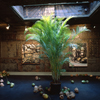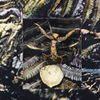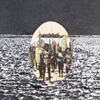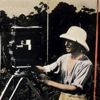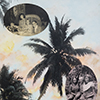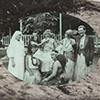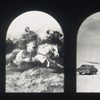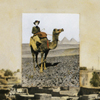Revenge of the Cocoanuts: A Curiosity Room. 1983–88 Desert Song. 1988 Click on images to view projects. |
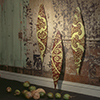 |
||||||||
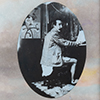 |
||||||||
|
|
|
||||||
Conceived as separate installations but exhibited only three months apart, these two projects are linked by their concern with Western culture’s colonial mythologizing of exotic foreign lands—specifically, the South Seas and the Middle East. Each project was realized as a total theatrical environment, amplifying the work’s content formally and conceptually.
Revenge of the Cocoanuts was shown at 56 Bleecker Street Gallery, New York, which had, in addition to the standard white-box gallery, an unrenovated back room with walls and ceilings covered in sheets of stamped tin. Taking advantage of the space’s brown-camouflage textures and colors, I installed a large potted coconut palm under the skylight and scattered approximately two hundred water coconuts on the floor. Photocollages and other photographic pieces hung around the space, and spurious artifacts stood propped against the walls. The installation was completed by a soundtrack: a compilation of ethnographic recordings of island music mixed with popular music. The tone of the whole environment—laden with humor, irony, and critique—was developed in the large framed photocollages. For example, Aloha features a seascape from the Solomon Islands overlaid with smaller vignettes culled from advertising, Hollywood movies, ethnography, and historical material. Twelve hand-tinted ovoid pictures disclose an array of (Western) tropical fantasies and fears—a surfer, a garbage-strewn beach, some headhunters, a scene from Jaws, General MacArthur and his officers wading on a South Pacific shore, Brooke Shields and Christopher Atkins in The Blue Lagoon, a woman diver, an illustration from Robinson Crusoe, and so on.
Desert Song was also influenced by its exhibition space, at Barbara Braathen Gallery, New York. An arched doorway to the front gallery was echoed in the arched format of the show’s black-and-white photographs. I painted the walls of the space a dark charcoal, covered the floor with tarpaper and black sand, piled fifty old cameras in the four corners of the room, and painted decorative motifs on a standing column. Desert Song also featured a soundtrack that mixed ethnographic recordings with popular music. As a whole the installation evoked the Middle East as a place of extremes and paradoxes, known to us mostly through outdated romantic images. The photomural is an enlargement of a picture of a desert oasis from a travel magazine. Another, four-part photopiece contrasts modes of transportation—camel and rider at an oasis, a still from Morocco with Marlene Dietrich and Gary Cooper, a detail of a painting by Delacroix, and a contemporary clash of cultures—a man parks his Chevy to use a phone booth in the desert. The ethnic and the kitsch, the actual and the advertised entwined and ultimately dissolved into a configuration of unstable anthropological data.
|
